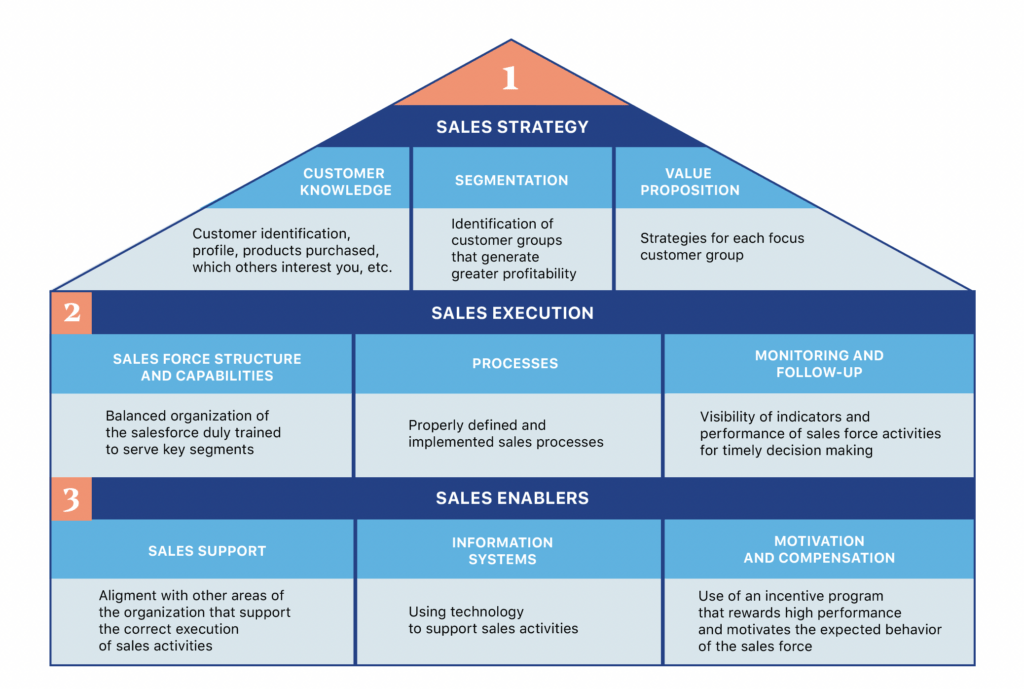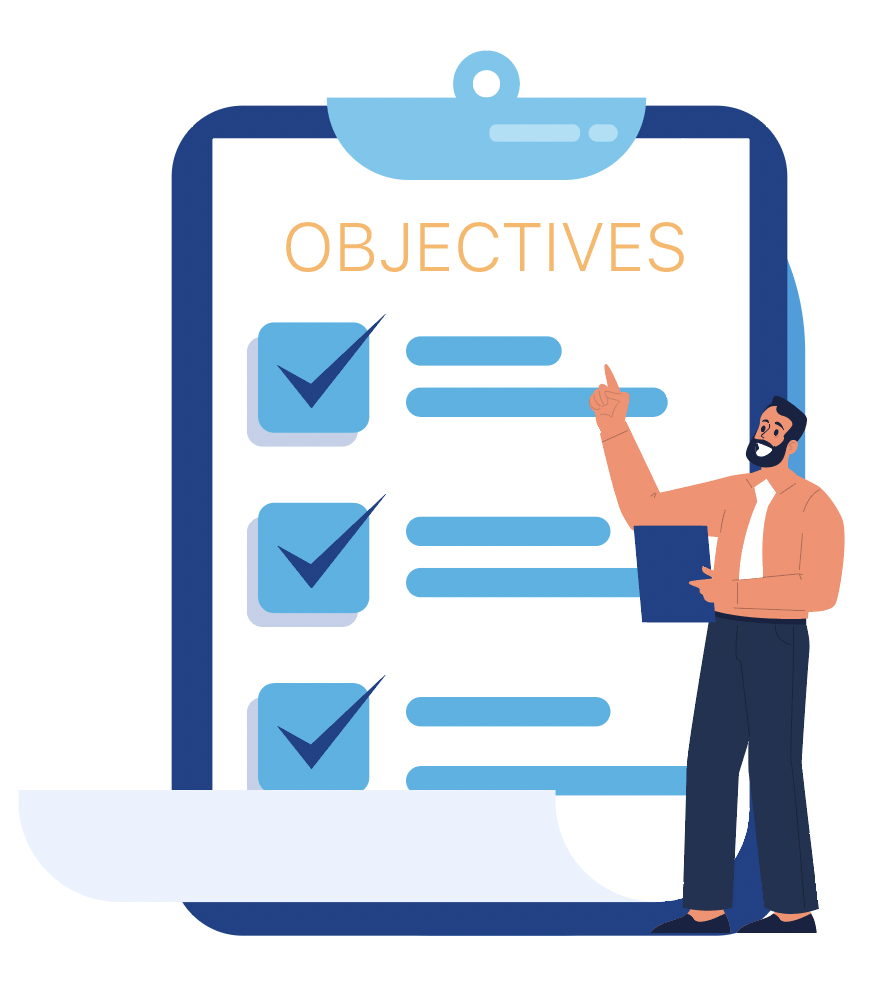IS YOUR SALES ENGINE RUNNING SMOOTHLY? 10 CRITICAL QUESTIONS TO ASSESS ITS OPERATIONAL PERFORMANCE
At the heart of a company’s growth and success lies its sales engine. This dynamic system encompasses a cohesive array of strategies, processes, and resources that empower the company to expertly attract, convert, and retain customers.
The health and adaptability of this engine is vital to achieve long-term business objectives given its integral role in competitiveness and business sustainability. There is little that can be done to ensure survival when a company consistently falls behind its sales targets.
Despite playing such an important role, sales operations are often left without adequate support, receiving insufficient attention from management, and lacking the human and technical resources necessary to operate well and prosper. Given the ubiquity of this situation, V2A offers a ten questions assessment based on our Sales Stimulation Framework (fig. 1) to evaluate the most critical issues to help CEOs and sales leaders gain a holistic view of the health and performance of their sales organization.
Figure 1: V2A’s Sales Stimulation Framework

ABOUT THE SALES STRATEGY
I. Are our sales objectives aligned with the company’s overall strategy and are they clearly communicated throughout the organization?
This strategic connection is essential to ensure consistency and focus on all levels of the company, as well as ensuring that all goals and efforts of the sales team are directed towards achieving the broader objectives of the organization, resulting in greater efficiency and overall success.

When sales objectives are in tune with the company’s strategy, a synergy is created that facilitates the proper allocation of resources, time, and effort. The sales team can direct its actions towards areas that generate the most value for the organization and customers. In addition, this alignment encourages collaboration and communication between the different areas, avoiding possible conflicts and redundancies, which allows a faster and more effective response to constant market changes.
For instance, consider a technology company aiming to increase market share in the enterprise sector. The company’s overall strategy is centered around innovation and providing tailored solutions to corporate clients. To align sales objectives with this strategy, the sales team is tasked with not only meeting revenue targets but also focusing on cultivating long-term relationships with key enterprise clients. The company communicates this alignment by clearly articulating the importance of client retention, upselling, and cross-selling in addition to new customer acquisitions.
II. Is our customer base clearly segmented by size and potential?
In a changing environment, this is critical as it allows the organization to understand more deeply and precisely the needs, preferences and behaviors of different customer groups, and therefore design realistic sales targets and solid strategies, as well as allocate resources efficiently by targeting the most valuable and profitable segments.
This refined understanding makes it easy to customize marketing and sales strategies that generate higher return on investment, further increasing the relevance of communications and offers. By tailoring messages and products to specific segments, companies can create stronger connections with customers, leading to greater retention, loyalty, and long-term satisfaction.
Companies that effectively segment their customers by size often experience notable revenue growth. Analyzing customer potential and tailoring marketing and sales efforts accordingly can significantly impact conversion rates.
Segmenting customers allows for more personalized communication and services, leading to improved customer satisfaction and retention. A survey by Bain & Company revealed that businesses effectively segmenting their customer base by size and potential experienced a 25% increase in customer retention rates compared to those with less focused segmentation (1).
III. How well do we know our customer and how effective are we in providing a value proposition that will meet that customer’s needs and wants?
 Once you have effectively segmented your customer base, the value of segmenting the sales force accordingly to achieve its goals becomes clearer. To appeal to a particular segment, sales teams will require a special set of skills or expertise in the relevant products or services, for example, most sales teams are divided into B2B and B2C. Beyond that first layer, B2B teams will segment Large Enterprises and treat them different to SMBs (small and medium businesses).
Once you have effectively segmented your customer base, the value of segmenting the sales force accordingly to achieve its goals becomes clearer. To appeal to a particular segment, sales teams will require a special set of skills or expertise in the relevant products or services, for example, most sales teams are divided into B2B and B2C. Beyond that first layer, B2B teams will segment Large Enterprises and treat them different to SMBs (small and medium businesses).
To excel in understanding their customers and delivering compelling value propositions, a successful sales team employs several best practices. Firstly, thorough market research and customer profiling help the team gain insights into the specific needs, preferences, and pain points of their target audience. Active listening during customer interactions further enhances this understanding. Regular communication channels, such as surveys and feedback loops, enable the team to stay attuned to evolving customer requirements.
Additionally, the team prioritizes ongoing training to stay updated on industry trends and product knowledge, ensuring they can effectively communicate the value of their offerings. Implementing a customer-centric approach, the sales team tailors their value propositions to align closely with the unique needs and wants of their clientele, fostering long-term relationships and customer satisfaction.
ABOUT THE SALES EXECUTION
IV. Are the recruiting activities focused on identifying and retaining top talent and developing sales capabilities needed?
Top sales performers possess not only the skills to close deals, but also the ability to build enduring relationships with clients. These individuals are not just revenue generators, they become brand advocates and sources of institutional knowledge.
By targeting and retaining such talent, a company can consistently achieve its sales goals, drive sustainable growth, and enhance its reputation in the market. Additionally, it’s often more cost-effective to invest in developing and retaining high-performing sales professionals rather than constantly recruiting and training new ones.
V. Are the sales representatives sufficiently trained with high-quality instruction to achieve successful sales?
 To achieve good closing rates, sales representatives need to be armed with certain skills as well as with technical knowledge. Namely, they need to have an adequate understanding of the offered goods or services, a good grasp of the needs and preferences of the clients they are selling to and they also need good communication abilities and sales techniques.
To achieve good closing rates, sales representatives need to be armed with certain skills as well as with technical knowledge. Namely, they need to have an adequate understanding of the offered goods or services, a good grasp of the needs and preferences of the clients they are selling to and they also need good communication abilities and sales techniques.
According to a study by CSO Insights, companies that invest in sales training see a 66.6% win rate, compared to a 48.4% win rate for companies with less emphasis on training (2). This indicates that well-trained sales teams have a higher likelihood of successfully closing deals. Additionally, an article from the Hubspot reported that organizations that provide ongoing sales training achieve a 50% higher net sales per employee (3). This suggests that continuous training in sales techniques contributes to increased sales productivity.
With regards to customer satisfaction, a study by the Aberdeen Group found that companies with effective sales training programs experience a 16.3% year-over-year improvement in customer satisfaction (4). Well-trained sales teams are better equipped to meet customer needs and expectations.
By investing in sales training, organizations not only prepare their reps to become trusted advisors, build strong customer relationships, and drive revenue growth, but also increase their confidence and satisfaction by feeling prepared to address challenges and answer questions with authority. It’s important to realize that unprepared sales reps may be costing the organization good leads. A survey by the Sales Education Foundation revealed that 71% of sales professionals believe that ongoing training and development opportunities positively impact their job satisfaction (5). This indicates that investing in training contributes to higher morale among sales teams.
VI. Do we have performance tracking systems in place, such as weekly reports or live dashboards?
It is fundamental to keep a close eye on performance metrics on both collective and individual levels. Measuring overall performance (through indicators of revenue, closing and conversion rates or customer acquisition costs) can help understand the organization’s real alignment with strategic goals, identify weaknesses or areas of opportunity and adjust operational processes.
On the other side, individual performance tracking can provide great insight into the strengths and weaknesses of the sales team members. This not only helps in identifying areas for improvement but also allows the company to assess the need for training and capabilities upgrading, ensuring that teams remain equipped with the right skills and knowledge.
Moreover, performance tracking enables the identification of the best performers, allowing for timely recognition, as well as the identification of underperformers to provide additional support or restructure teams.
In summary, having accurate performance tracking systems in place is key to drive informed decision-making and continuous improvement. These tracking systems provide real-time and historical insights into key performance metrics, allowing organizations to assess the effectiveness of their strategies and make data-driven adjustments as needed, through monitor progress, identify trend and patterns, set and evaluate goals, improve accountability, optimize resource allocation, enhance communication and collaboration.
ABOUT SALES ENABLERS
 VII. Do we have real clarity about the effectiveness of our sources of “leads”?
VII. Do we have real clarity about the effectiveness of our sources of “leads”?
Even when it’s clear that different sources of leads work in different ways, it is common for companies to lack accurate information about how each is performing. This often leads to overspending on inefficient sources and wasting the potential of the best ones. For example, we have seen companies spending a lot of money in social media adds when in fact most new clients come from referral programs that are not nearly as well funded.
In addition to enabling better resource allocation, visibility into the cost-performance ratios of the different lead sources of a sales organization can help assess and refine the marketing strategies that are being implemented.
A live digital dashboard fed with CRM and financial data sets is often the best way to track and compare the performance of the different lead sources because it provides a comprehensive, real-time, and customizable platform for tracking and comparing. This approach enhances data-driven decision-making, promotes collaboration, and aligns with the broader business goals of driving revenue and profitability.
VIII. Do we have visibility of the cost of our sales engine? (considering the different activities)
Having clear and detailed visibility into the cost of your sales engine is fundamental to making informed and strategic decisions. Some companies won’t stop calling prospects until the 10th time without considering the added cost and realistic closing opportunities.
Knowing the costs associated with sales activities, from customer acquisition to relationship maintenance, allows you to assess the profitability of your efforts and allocate resources efficiently.
This visibility makes it easy to identify areas where you can cut costs, as well as identify investments that generate a positive return. By having a clear understanding of costs, the company can adapt its approach, adjust strategies, and take proactive steps to optimize sales engine effectiveness and ensure long-term financial health.
IX. Is technology being appropriately leveraged to support sales activities?
 Technology is a must in today’s world. Leveraging the right tools in sales processes allows you to transform the way you interact with customers, manage data, and execute business strategies
Technology is a must in today’s world. Leveraging the right tools in sales processes allows you to transform the way you interact with customers, manage data, and execute business strategies
Technology offers tools to automate processes, improve efficiency and accuracy in managing customer information, and provide real-time analytics to make informed decisions.
In addition, technological solutions allow a more effective tracking of customer interactions, leading to more personalized service, a deeper understanding of customer needs, and increased sales conversion through lean systems-enabled procurement, processing, and order status processes which are properly interconnected.
X. Do we have real knowledge of the motivation levels among our teams? (through coaching sessions, periodic questionnaires, 1 on 1, etc.)
Sales force motivation is a critical success factor, as it directly influences the energy, commitment, and performance of reps. A motivated sales force not only works with passion and determination to achieve their goals, but also tends to maintain a positive and proactive approach in their interaction with customers. High morale is essential, especially in difficult times.
Organizations must understand the importance of keeping a finger on the pulse of their workforce and regularly assessing their motivation levels, to create an environment in which teams can reach their full potential, thus contributing to the continued growth and success of the company.
CONCLUSION
Assessing the effectiveness of your sales engine is crucial for ensuring the long-term success of your organization. By regularly evaluating the various components of your sales process, from strategy and execution to enablers, you can identify areas for improvement and make informed decisions that will drive revenue growth and customer satisfaction.
By asking the 10 questions outlined in this article, you can gain valuable insights into the effectiveness of your sales engine and take steps to optimize its performance. Remember, a healthy sales engine is the heart of a thriving business.
Click here to take our sales engine assessment.
If you need help to improve your sales engine’s performance or want to learn more about this topic, contact our experts in V2A’s Strategy and Growth Practice: www.v2aconsulting.com.
At V2A we have carried out multiple sales stimulation projects in different industries, helping our clients define their strategic framework, as well as their specific focus areas, objectives and goals. Also, we have carried out geographic and demographic studies, among other analyses to examine the customer bases, obtaining as a result an increase in their sales effectiveness.
Sources:
(1) Prescription for cutting costs; https://media.bain.com/Images/BB_Prescription_cutting_costs.pdf ; Fred Reichheld
(2) CSO Insights, Fifth Annual Sales Enablement Study; https://salesenablement.pro/assets/2019/10/CSO-Insights-5th-Annual-Sales-Enablement-Study.pdf
(3) How to Increase Net Sales by 50% Per Salesperson https://blog.hubspot.com/sales/how-to-increase-net-sales-per-salesperson-infographic ; Leslie Ye, 2017
(4) 5 Steps to Turning Your Employee Engagement Program into Improved Customer Satisfaction https://www.aberdeen.com/hcm-essentials/5-steps-to-turning-your-employee-engagement-program-into-improved-customer-satisfaction/; By Michael Moon, October 27th, 2015
(5) How Learning and Development Can Attract—and Retain—Talent https://www.shrm.org/topics-tools/news/all-things-work/how-learning-development-can-attract-and-retain-talent ; Kate Rockwood, 2022
